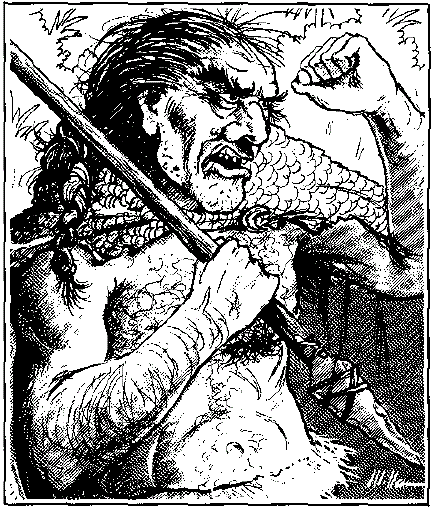
| Climate/Terrain: | Swamps, tropical forests |
|---|---|
| Frequency: | Rare |
| Organization: | Tribal |
| Activity Cycle: | Any |
| Diet: | Omnivorous |
| Intelligence: | Average (8-10) |
| Treasure: | D |
| Alignment: | Neutral |
| No. Appearing: | 1-3 |
| Armor Class: | 4 or 0 |
| Movement: | 12 |
| Hit Dice: | 15+5 |
| THAC0: | 5 |
| No. of Attacks: | 1 or 2 |
| Damage/Attack: | 1d8 + 9/1d8 + 9 or by weapon 2d6 + 9 |
| Special Attacks: | Hurl spears (1d10 + 9), spells |
| Special Defenses: | See below |
| Magic Resistance: | Nil |
| Size: | H (16' tall) |
| Morale: | Champion (15-16) |
| XP Value: | Infant: -5HD 2,000; Juvenile: -2HD 6,000; Adult: 9,000-10,000; Shaman: 10,000-11,000 |
Swamp giants are believed to have evolved ages ago from bosk giants. These smaller, stockier giants are more intelligent than the nearby bosk and have learned the rudiments of civilization.
Swamp giants have green skin and hair like that of the bosk, and therefore are quickly mistaken for their slow-witted cousins. However, there are differences. Swamp giants tend to wear their hair long, usually braided and festooned with ornaments collected from battle. Further, they have facial hair, which most of them keep trimmed.
A swamp giant's natural armor class is 4. However, many of the adult males wear the skin of young green dragons. This skin, cured in a manner known only to these giants, lowers their armor class to 0. their coloration gives them a +3 chance to surprise opponents and a -3 chance to be surprised. Giants in green dragon armor have a +2 surprise bonus and -2 AC bonus. All swamp giants regenerate 5 hit points of damage per round.
Combat: Swamp giants fight only when they believe their territory is in danger. They prefer to reason with a foe first (with the exception of dragons). They often choose a leader when going into battle and follow his directions. They prefer to circle their quarry, using their coloration to blend into the foliage.
They begin their assaults with spells. Because swamp giants are so tuned to their environment,from birth they are able to cast entangle three times a day and plant growth once a day. A favorite tactic is to trap prey in a tangle of vegetation, then slaughter it with a vlley of spears. Each giant can throw two spears per round.
Habitat/Society: Swamp giants prefer to live in trees, in simple homes constructed of wood and reeds. Of course, the ttrees they choose for homes are immense, usually at least 10 to 20 feet in diameter and 100 fett or more tall.
They generally live peaceful lives, staying to themselves and interacting with the bosk only when their cousins wish to trade. The swamp giants are known for crafting wooden bowls, dishes, and other objects that the bosk covet.
When more than four swamp giants are encountered, they are a mated pair and infants or juveniles.
When encountered in their lair, there are 4d4+6 giants, one half of these adults. The remainder are infants and juveniles. An infant has 10 HD and has only a +5 damage bonus. A juvenile at 13 HD has a +7 damage bonus. If a village is threatened, the adults protect the infants and juveniles.
For every 10 giants encountered, there is a 30% chance one is a shaman, a giant who is the equivalent of a 1st-6th level druid. These shamans are respected in swamp giant communities and are often sought as advisors by the village leader.
All the villages recognize a king. He is considered the strongest and wisest of the swamp giants and other giants look to him to appoint village leaders.
Ecology: Swamp giants live off the land, hunting and foraging for food. Many of them grow a large, ricelike crop. They do not keep animals for food. Their favorite meat is the flesh of young green dragons. In turn, older green dragons like to hunt the swamp giants.
